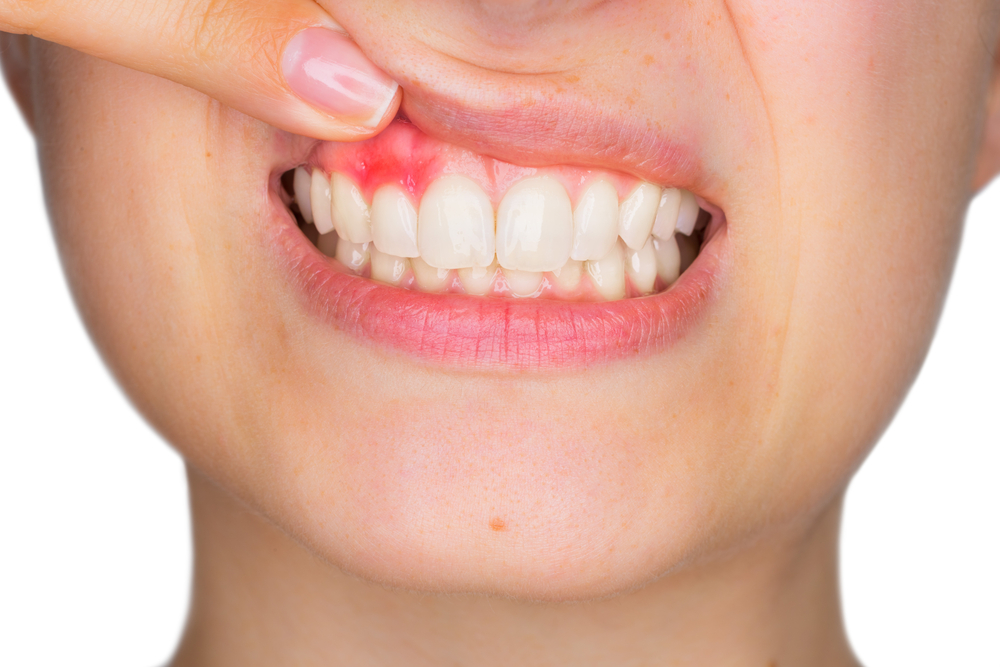While there are several important parts of the mouth and jaw that are involved in dental care, one of the most understated in many swaths of the population is the gums. Some of us spend plenty of time and attention on our teeth themselves, but don’t do enough to care for the gums that hold and support them.
At Bright Side Dental & Orthodontics, we pay extremely close attention to every relevant part of the mouth and jaw as part of our general dentist services, including the gums and the important role they play in overall oral care. In particular, we take a number of steps to help all our patients prevent any significant risk of gum disease, which is potentially harmful not only to the gums themselves and the mouth, but to your overall long-term health as well. Here’s a primer on gum disease and how it forms, the problems it creates, and how to spot the signs of gum disease plus limit its risks.

Gum Disease Basics and Types
Gum disease is a broad categorization that refers to conditions characterized by inflammation and infection of the gums. The primary cause of gum disease in all people is bacteria, which tends to fester on plaque – a thin film that forms on the teeth over time after eating or drinking. One of the primary goals of brushing and flossing the teeth, as you’ve surely heard from a dentist or two in your life, is to remove this plaque before it causes issues; if this is not done properly, however, gum disease is one of several potential results.
The initial stage of gum disease is known as gingivitis, something many of us have heard of. During this initial stage, one that can be easily diagnosed by a dentist, gum disease has not progressed much and is possible to deal with through basic treatment and improved habits, such as flossing and brushing more often and more effectively.
However, if gum disease is not treated properly during the gingivitis stage, several issues may arise as a result. Specifically, gum disease will progress to what’s known as periodontal disease, or periodontitis, which has a few different types:
- Aggressive periodontitis: A type that happens in otherwise healthy people, this is a condition that quicky destroys the gums, jawbone and ligaments in the mouth.
- Chronic periodontitis: The most common type, progressing slower than the aggressive variety.
- Necrotizing periodontitis: Mostly seen in people who have weaker immune systems or specific immune conditions, this is a condition where gum tissues actually die, as do the ligaments that secure the teeth and the jawbone itself.
Over 75 million Americans have gum disease of some type, but only a tiny percentage of these people are actually aware of it. If you have an understanding of the symptoms and signs of gum disease, however, you’ll be more easily able to spot it – and prevent it from ever happening to you or anyone in your family.
Related Health Problems
It’s important to note that while gum disease, particularly periodontitis, can be very serious in the mouth, this isn’t even the extent of the potential risks associated with it. In fact, there’s been tons of research connecting gum disease to several other health issues, from immune system concerns to issues with infections and many others. Those with serious gum disease problems often have to endure a number of additional issues with their overall health as well.
Habits and Other Causes of Gum Disease
We want to be clear: The single habit that’s most closely connected with gum disease is poor oral health. Brushing and flossing the teeth regularly, properly and for the required amounts of time is vital to preventing gum disease of all types – those who do not are simply at much higher risk here than those who do.
However, there are also additional habits, behaviors or general factors that contribute to gum disease risks, including a couple that you may have little or no control over. These include:
- Diet: If you eat lots of processed sugars and carbohydrates, you will have more sugar in your mouth on a regular basis – and sugar is a top potential cause of bacterial buildup in the mouth, which leads to gum disease.
- Dry mouth: Hydration is important in the body for many reasons, and one is the way it helps wash away bacteria in the mouth. If you have a frequently dry mouth, whether due to not drinking enough water, a medication issue or some other concern, this could lead to gum disease risks.
- Severe diseases: In other cases, serious diseases or auto-immune disorders like cancer, HIV or diabetes will cause heightened risks of gum disease because of the ways they compromise the immune system.
- Hormones: Fluctuations in hormones may lead to gum sensitivity, which means people who are pregnant, in puberty, in menopause or in menstruation may have higher risks of gum disease forming.
- Tobacco use: In any form, whether it’s cigarettes or another, tobacco leaves toxins in the mouth that limit your immune response and raise the risk of gum disease (and many other problems).
Symptoms of Gum Disease
Here are some signs or symptoms that you may be dealing with gum disease:
- Chronic bad taste in the mouth, or bad breath, regardless of how often you brush or take other measures
- Changes to bite or the fit of dentures
- Loose or missing teeth
- Pain in the gum area
- Bleeding during or after brushing or flossing
- Pockets between the gums and teeth
- Receding gums
- Pus between the teeth
- Swelling or inflammation in the gums
For more on gum disease and how to spot and prevent it, or to learn about any of our family dentist services, speak to the staff at Bright Side Dental today.